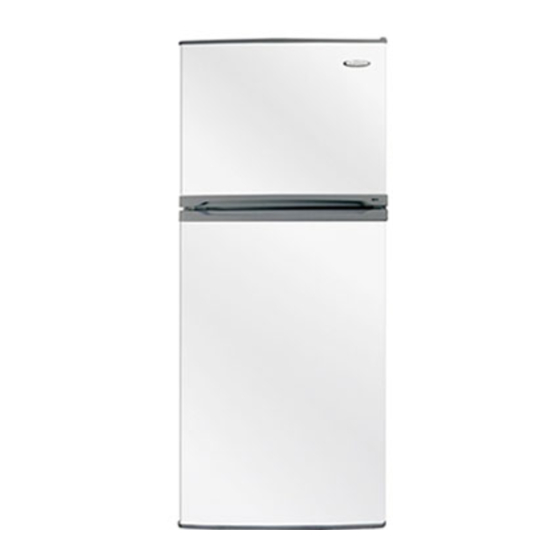
Table of Contents
Advertisement
Quick Links
Advertisement
Table of Contents

Subscribe to Our Youtube Channel
Summary of Contents for Frigidaire FTNF52782GSKR
- Page 1 USER MANUAL MODEL #’s: FTNF52782GSKR LANGUAGES: English & Arabic...
- Page 3 1.FREEZER BIN 7.LAMP COVER 2.REFRIGERATOR BIN 8.REFRIGERATOR TEMPERATURE CONTROL KNOB 3.BOTTLE SHELF 9.REFRIGERATOR SHELF 4.BOTTOM BOTTLE SHELF 10.CRISPER COVER 5. FREEZER SHELF 11.CRISPER 6. FREEZER TEMPERATURE CONTROL KNOB 12.LEVELING LEG...
-
Page 4: Important Safety Instructions
WARNING : Never touch the interior of the Freezer Chamber or frozen foods in the compartment with wet hands as this could result in frost bite. IMPORTANT SAFETY INSTRUCTIONS To reduce the risk of fire, electrical shock, WARNING or injury when using your refrigerator, follow these basic precautions:... -
Page 5: Operating Your Refrigerator
consumption. Ambient temperature below 50° F or above 85° F will hinder the performance of this appliance. This unit is not designed for use in a garage or any other outside installation. Avoid locating the refrigerator in moist areas. ... -
Page 6: Operating Freezer Compartment
putting foods inside. This will ensure the cabinet is thoroughly chilled before food is put in. The range of the REFRIGERATOR temperature control is from position "MIN" the warmest to "MAX" the coldest. Adjust the temperature control to the setting that best suits your needs. The setting of “MED”... -
Page 7: Care And Maintenance
to shorten the time of making ice, you can set the temperature control knob at “MAX”. Notes: Do not store can foods or food stored in glass containers in the freezer compartment. The Freezer Compartment This compartment is designed for the long-term storage of frozen food. Storage time period is up to three months. -
Page 8: Troubleshooting Guide
Let hot foods cool to room temperature before placing in the refrigerator. Overloading the refrigerator forces the compressor to run longer. Foods that freeze too slowly may lose quality, or spoil. Be sure to wrap foods properly, and wipe containers dry before placing them in the refrigerator. This cuts down on frost build-up inside the refrigerator. - Page 9 Temperature of external refrigerator surface is The exterior refrigerator walls can be as much as warm. F warmer than room temperature. This is normal while the compressor works to transfer heat from inside the refrigerator cabinet. Popping or cracking sound when compressor Metal parts undergo expansion and contraction, comes on.
- Page 11 1.FREEZER BIN 7.LAMP COVER 2.REFRIGERATOR BIN 8.REFRIGERATOR TEMPERATURE CONTROL KNOB 3.BOTTLE SHELF 9.REFRIGERATOR SHELF 4.BOTTOM BOTTLE SHELF 10.CRISPER COVER 5. FREEZER SHELF 11.CRISPER 6. FREEZER TEMPERATURE CONTROL KNOB 12.LEVELING LEG...
- Page 12 WARNING : Never touch the interior of the Freezer Chamber or frozen foods in the compartment with wet hands as this could result in frost bite. IMPORTANT SAFETY INSTRUCTIONS To reduce the risk of fire, electrical shock, WARNING or injury when using your refrigerator, follow these basic precautions:...
- Page 13 consumption. Ambient temperature below 50° F or above 85° F will hinder the performance of this appliance. This unit is not designed for use in a garage or any other outside installation. Avoid locating the refrigerator in moist areas. ...
- Page 14 putting foods inside. This will ensure the cabinet is thoroughly chilled before food is put in. The range of the REFRIGERATOR temperature control is from position "MIN" the warmest to "MAX" the coldest. Adjust the temperature control to the setting that best suits your needs. The setting of “MED”...
- Page 15 to shorten the time of making ice, you can set the temperature control knob at “MAX”. Notes: Do not store can foods or food stored in glass containers in the freezer compartment. The Freezer Compartment This compartment is designed for the long-term storage of frozen food. Storage time period is up to three months.
- Page 16 Let hot foods cool to room temperature before placing in the refrigerator. Overloading the refrigerator forces the compressor to run longer. Foods that freeze too slowly may lose quality, or spoil. Be sure to wrap foods properly, and wipe containers dry before placing them in the refrigerator. This cuts down on frost build-up inside the refrigerator.
- Page 17 Temperature of external refrigerator surface is The exterior refrigerator walls can be as much as warm. F warmer than room temperature. This is normal while the compressor works to transfer heat from inside the refrigerator cabinet. Popping or cracking sound when compressor Metal parts undergo expansion and contraction, comes on.









Need help?
Do you have a question about the FTNF52782GSKR and is the answer not in the manual?
Questions and answers